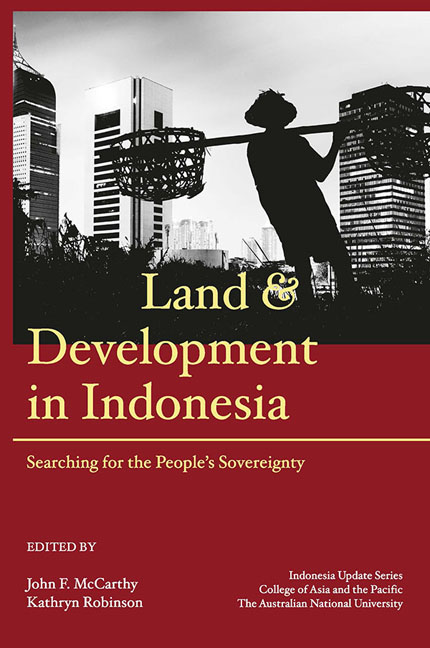Book contents
- Frontmatter
- Contents
- Tables
- Figures
- Contributors
- Acknowledgements
- Glossary
- Map
- 1 Land, economic development, social justice and environmental management in Indonesia: the search for the people's sovereignty
- PART 1 LAND USE AND LAND LAW: THE BIG PICTURE
- PART 2 ENVIRONMENTAL AND CUSTOMARY FRAMING OF LAND TENURE
- PART 3 URBAN AND INFRASTRUCTURE DEVELOPMENT
- PART 4 AGRICULTURE, LAND TENURE AND LIVELIHOODS
- PART 5 LARGE-SCALE LAND ACQUISITIONS AND SMALLHOLDER DEVELOPMENT
- 13 Industrial plantations and community rights: conflicts and solutions
- 14 How can the people's sovereignty be achieved in the oil palm sector? Is the plantation model shifting in favour of smallholders?
- 15 Beyond special autonomy and customary land rights recognition: examining land negotiations and the production of vulnerabilities in Papua
- Index
- Miscellaneous Endmatter
14 - How can the people's sovereignty be achieved in the oil palm sector? Is the plantation model shifting in favour of smallholders?
from PART 5 - LARGE-SCALE LAND ACQUISITIONS AND SMALLHOLDER DEVELOPMENT
Published online by Cambridge University Press: 29 July 2017
- Frontmatter
- Contents
- Tables
- Figures
- Contributors
- Acknowledgements
- Glossary
- Map
- 1 Land, economic development, social justice and environmental management in Indonesia: the search for the people's sovereignty
- PART 1 LAND USE AND LAND LAW: THE BIG PICTURE
- PART 2 ENVIRONMENTAL AND CUSTOMARY FRAMING OF LAND TENURE
- PART 3 URBAN AND INFRASTRUCTURE DEVELOPMENT
- PART 4 AGRICULTURE, LAND TENURE AND LIVELIHOODS
- PART 5 LARGE-SCALE LAND ACQUISITIONS AND SMALLHOLDER DEVELOPMENT
- 13 Industrial plantations and community rights: conflicts and solutions
- 14 How can the people's sovereignty be achieved in the oil palm sector? Is the plantation model shifting in favour of smallholders?
- 15 Beyond special autonomy and customary land rights recognition: examining land negotiations and the production of vulnerabilities in Papua
- Index
- Miscellaneous Endmatter
Summary
On the surface, oil palm appears to be dominated by large plantations. However, […] the facts that smallholders now account for over 40% of the oil palm area in Indonesia, the largest producer, and 80% in Thailand the third largest producer indicate that the structure of the industry is already shifting (Byerlee 2014: 584).
This statement is part of Byerlee's historical analysis of the evolution of agrarian structures in tropical Asia between 1850 and about 2000, using case studies of tea, rubber, cassava and oil palm. Byerlee argues that economic conditions in colonial states (such as pioneering costs and risks) favoured the plantation model, as well as discriminatory attitudes towards smallholders and a preference for cheap land and labour. Three of the four commodities he studied had moved largely to smallholder production by the end of the twentieth century.
While he acknowledges that the Thai oil palm industry never had a tradition of large plantations, Byerlee uses the example of Thailand to show what may be possible: a government that forbids foreign ownership of farmland and consistently supports smallholders; an agricultural bank that provides long-term loans for tree crops; farm holdings of 4–8 hectares; farmers with generally secure tenure; and large numbers of mills competing for farmers’ fruit (Byerlee 2014: 584).
However, the ‘rebirth’ of large plantations in parts of mainland Southeast Asia (Laos, Cambodia and Myanmar) and the continuation of the plantation model for oil palm in Sumatra, Borneo and New Guinea appear to refute his argument. Byerlee wonders whether this indicates a change in the economic fundamentals of technology and markets, or whether it is more the result of ‘state policies and investor “mindsets”’ (Byerlee 2014: 575). He perceives this resurgence of large plantations to be a ‘temporary aberration’ from the long-term trend towards smallholders.
Byerlee acknowledges that, for smallholders to be competitive, their farms must increase in size and productivity. Much will depend on a local political economy ‘that levels the playing field for smallholders through development of basic services of research, extension, land tenure security and financial institutions’ (Byerlee 2014: 592). He argues, in the meantime, for coexistence and mutually beneficial partnerships between smallholders and ‘responsible agribusiness companies’, a call echoed in a recent Oxfam Discussion Paper by consulting group Aidenvironment (2014).
- Type
- Chapter
- Information
- Land and Development in IndonesiaSearching for the People's Sovereignty, pp. 315 - 342Publisher: ISEAS–Yusof Ishak InstitutePrint publication year: 2016

